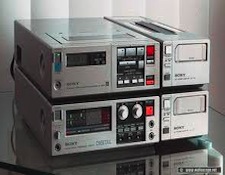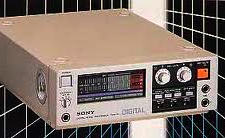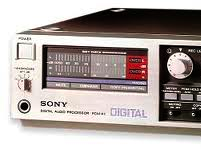It’s the time of year for saving money!

Before Blu-Rays, SACDs, DVD-HDs, CDs, DATs, and even Laser
Discs, there was a digital recording technology called PCM, which stands for
Pulse Code Modulation.
The first PCM recorders were in 1977. The first technical hurdle in PCM’s creation was
the development of linear 16-bit Analog-to-digital and digital-to-analog
converters. At first Sony used a 14-bit convertor (and the first PCM encoders
from Sansui and Samsung were also 14-bit devices), but Sony soon developed a
reliably linear 16-bit chipset, which was what Sony used in their first Sony
PCM recorder, the F-1.
The PCM F-1 was priced at $1900, and it required an additional
piece of gear to operate – a video recorder. Often purchased with Sony’s
SL-2000 VCR recorder, the PCM F1/SL-2000 system was the first portable,
affordable, digital recording system. Although bulky by today’s standards, the two
pieces shared a rechargeable battery system that made it possible to actually
record in the field without AC power.
Sony’s use of the existing VHS and Beta video recorder formats
for the PCM digital recorders was both brilliant and problematic. It was
brilliant because it gave anyone using the PCM format a wide variety of readily
available recording machines to interface with their PCM units. But it was
problematic because videotape, especially at the beginning of a cassette, was
prone to exhibit dropouts and signal loses. Most recording engineers soon
adopted the policy of not even recording on the first couple of minutes of
tape. I know when J. Gordon Holt and I
used our PCM recorders, we left the first five minutes blank as a matter of
standard operating procedure.
 The first CD player, Sony’s CDP-101, used the same liner 16-bit D/A convertor as the PCM-F1 recorder, but even back when it was first
The first CD player, Sony’s CDP-101, used the same liner 16-bit D/A convertor as the PCM-F1 recorder, but even back when it was first
introduced the CDP-101 didn’t sound nearly as good as the PCM F-1. Even today,
when I play back PCM F-1 recordings that I made in the mid-eighties I’m often
delighted by how good they can sound.
Soon after the PCM F-1 was released, Sony added other, more
studio-oriented, full-sized PCM recorders. These models included the PCM-501,
PCM-601, and PCM-701. Although the PCM-701 was heralded as the “top of the line,”
it lacked one key feature that Sony included in its less expensive PCM-601 – a S/PDIF digital output. To this day, the
Sony PCM-601 is the only PCM recorder I’ve seen that allows for direct digital
copies without going through a digital to analog conversion.
In many ways the R-DAT format was merely PCM-lite. It used the
same rotary-head recording scheme as video recorders, but reduced the
transport’s size. R-DAT also suffered (and still suffers) from similar dropout
issues, especially during at the beginning of a cassette.

As someone who owns examples of the Sony PCM-F1, PCM-501,
PCM-601, and PCM-701 recorders, I can readily attest to the high construction
standards of the units themselves as well as their sound quality. And if Sony
had not developed, released, and had commercial success with the PCM F-1
recorder, they would have never been in a position to develop the compact disc (the compact disc format was a co-development technology between
Sony and Philips which prevailed over all competing disc proposals).
To call the Sony PCM-F1 the most significant audio product of
the last half of the 20th century would not, in my humble opinion,
be a stretch. It will always hold a very special place in the history of sound
recording.
Much thanks to Marc Finer for fact-chacking and supplying background information for this article.





